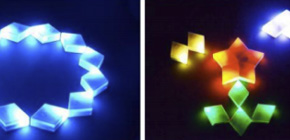
Synchronized fluctuation-type art illumination developed, a world first!
An industry-university collaboration joint research team led by Osaka University developed synchronized fluctuation-type art illumination, in which the natural rhythm (tremor) of candle light can be produced even in artificial light by using technology to synchronize fluctuations in light with rhythms in nature.
For ages, candle light has been used for artistic illumination as a tool to create a cozy setting. As technology progresses, artistic illumination using LED, such as the kind seen in flameless candles, has become popular in recent years. It is said that the market size of such LED illumination in the U.S. is a few billion dollars per year.
In the biological system, each biological oscillator collectively synchronizes with each other, producing a variety of rhythms. The biological rhythm has 1/f fluctuations and synchronizes internal cycles with the external environment.
It was possible to reproduce light fluctuations on a digital processor by programming a formula of biological rhythmic phenomena created by using non-linear mathematical models. However, it was difficult to put these light fluctuations into practice because of the heavy computation load and costs due to real-time information processing of the combinations of many oscillators (vibrating cells).
In such a setting, this group announced a concept model of synchronized fluctuation-type art illumination that has both ‘1/f fluctuations’ and ‘synchronized sensing,’ or a sensor enabling synchronization.
“The patented technology used in this fluctuation-type art illumination adds naturalness to light by employing ‘comfort by 1/f fluctuations’ and ‘synchronized sensing,’ both of which are seen in biological rhythm, to actively synchronize illumination with the external environment,” team leader Teruo Kanki of Osaka University said. “So, this technology has a great advantage in that it’s possible to develop the system and equipment no matter how many combinations of synchronized oscillators are present.”
The establishment of this pioneering illumination standard using synchronized sensing, which synchronizes with environmental factors and does not disturb human biological rhythm, will create social innovation to enhance quality of life.
Figure 1. The synchronized fluctuation-type art illumination (credit: Hakuhodo Inc.)
This fluctuation-type art illumination was jointly developed by Osaka University, University of Hyogo, ZERO BY ZERO, and Hakuhodo Inc. for the purpose of pursuing electronics technology that harmonizes with nature and is human-friendly.
Related link

